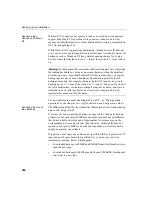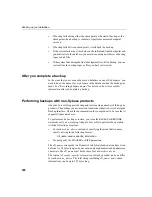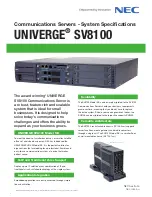
Backing up your database
384
...TO ’
archive_device’ [ SIZE #_of_KB ][STACKER #_of_drives_in_stack
] ...
[ WITH COMMENT ’
string’ ]
Note
If you need to back up an Adaptive Server Anywhere database, see the
Adaptive Server IQ Reference Manual for additional options.
Specifying operator presence
ATTENDED ON
or
OFF
controls whether or not human intervention is expected
when new tapes or disk files are needed. The default is
ON
.
For unattended backups to disk,
BACKUP
does not prompt you to add more
disk space. If you run out of space, an error occurs and
BACKUP
halts.
For unattended backups to tape,
BACKUP
does not prompt for a new tape to be
loaded. The
SIZE
and
STACKER
options determine what happens if you run out
of space. See the information on these options under “Specifying archive
devices”.
Specifying the type of backup
FULL | INCREMENTAL | INCREMENTAL SINCE FULL
specifies the type of
backup. Choose one:
•
FULL
causes a full backup of both the Catalog Store and the IQ Store.
FULL
is the default action.
•
INCREMENTAL
makes a full backup of the Catalog Store, and then backs
up all changes to the IQ Store since the last IQ backup of any type.
•
INCREMENTAL SINCE FULL
makes a full backup of the Catalog Store, and
then backs up all changes to the IQ store since the last full IQ backup.
For guidance in selecting a backup type, see “Scheduling routine backups”.
Specifying archive devices
The
TO
archive_device
clause indicates the destination disk file(s) or system
tape drive(s) for the backup. You specify one
TO
archive_device
clause for each
destination file or device. At least one is required.
BACKUP
distributes output
in parallel—that is, concurrently—across all of the devices you specify. For
faster backups you should specify more devices, up to the number your
hardware platform supports.
Summary of Contents for Adaptive Server IQ 12.4.2
Page 1: ...Administration and Performance Guide Adaptive Server IQ 12 4 2 ...
Page 16: ...xvi ...
Page 20: ...Related documents xx ...
Page 40: ...Compatibility with earlier versions 20 ...
Page 118: ...Troubleshooting startup shutdown and connections 98 ...
Page 248: ...Importing data by replication 228 ...
Page 306: ...Integrity rules in the system tables 286 ...
Page 334: ...Cursors in transactions 314 ...
Page 396: ...Users and permissions in the system tables 376 ...
Page 438: ...Determining your data backup and recovery strategy 418 ...
Page 484: ...Network performance 464 ...
Page 500: ...System utilities to monitor CPU use 480 ...
Page 514: ...Characteristics of Open Client and jConnect connections 494 ...
Page 536: ...Index 516 ...
















































